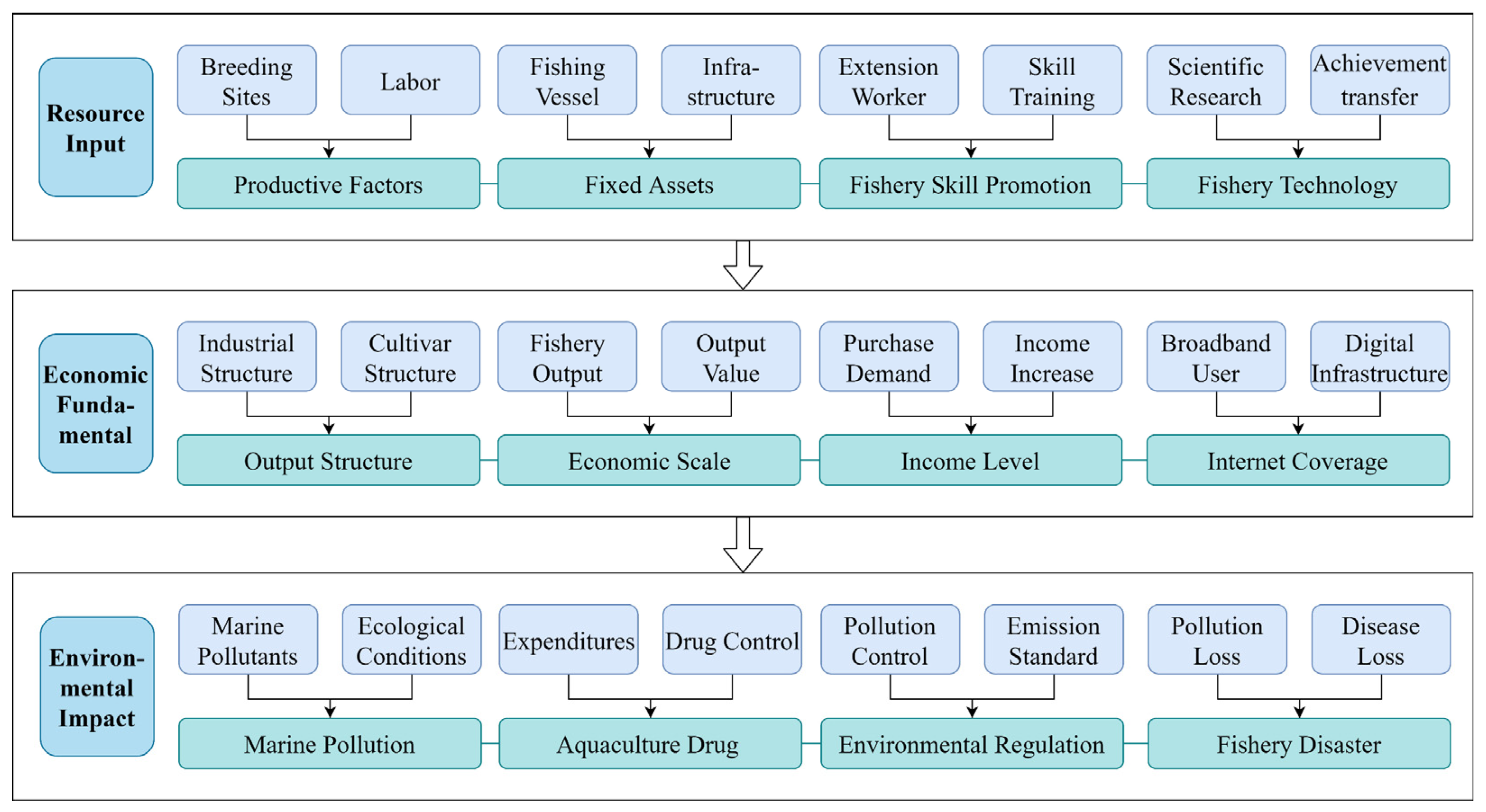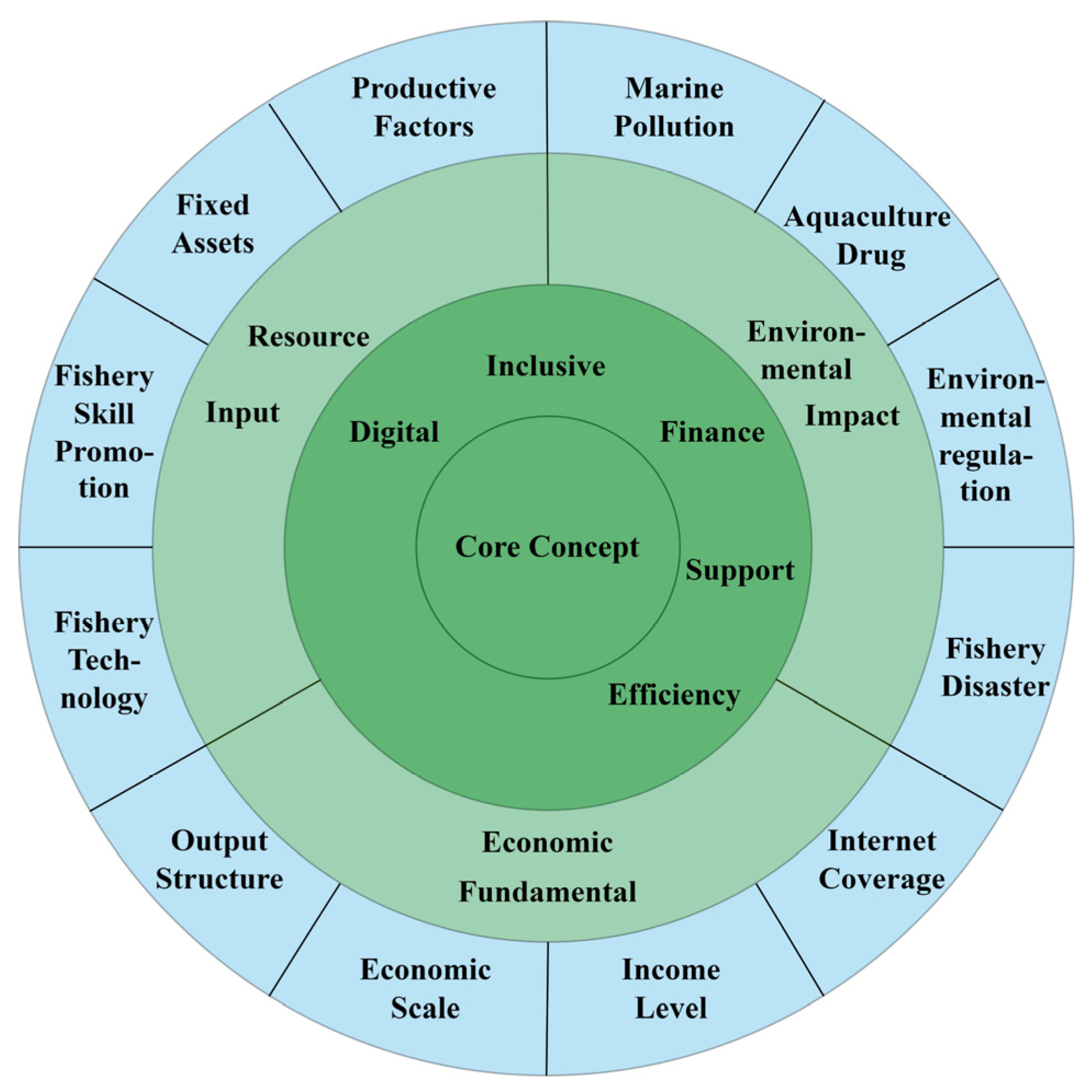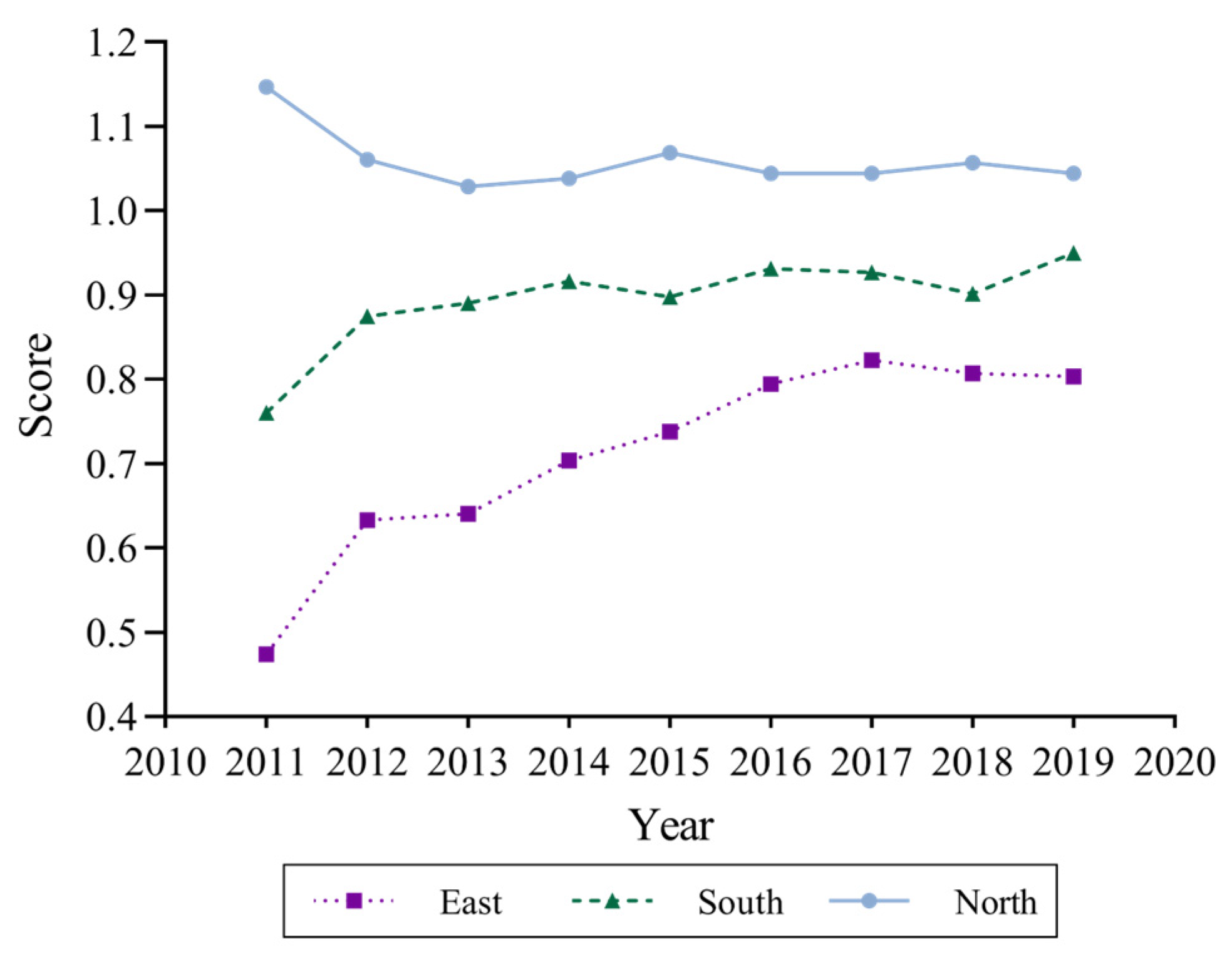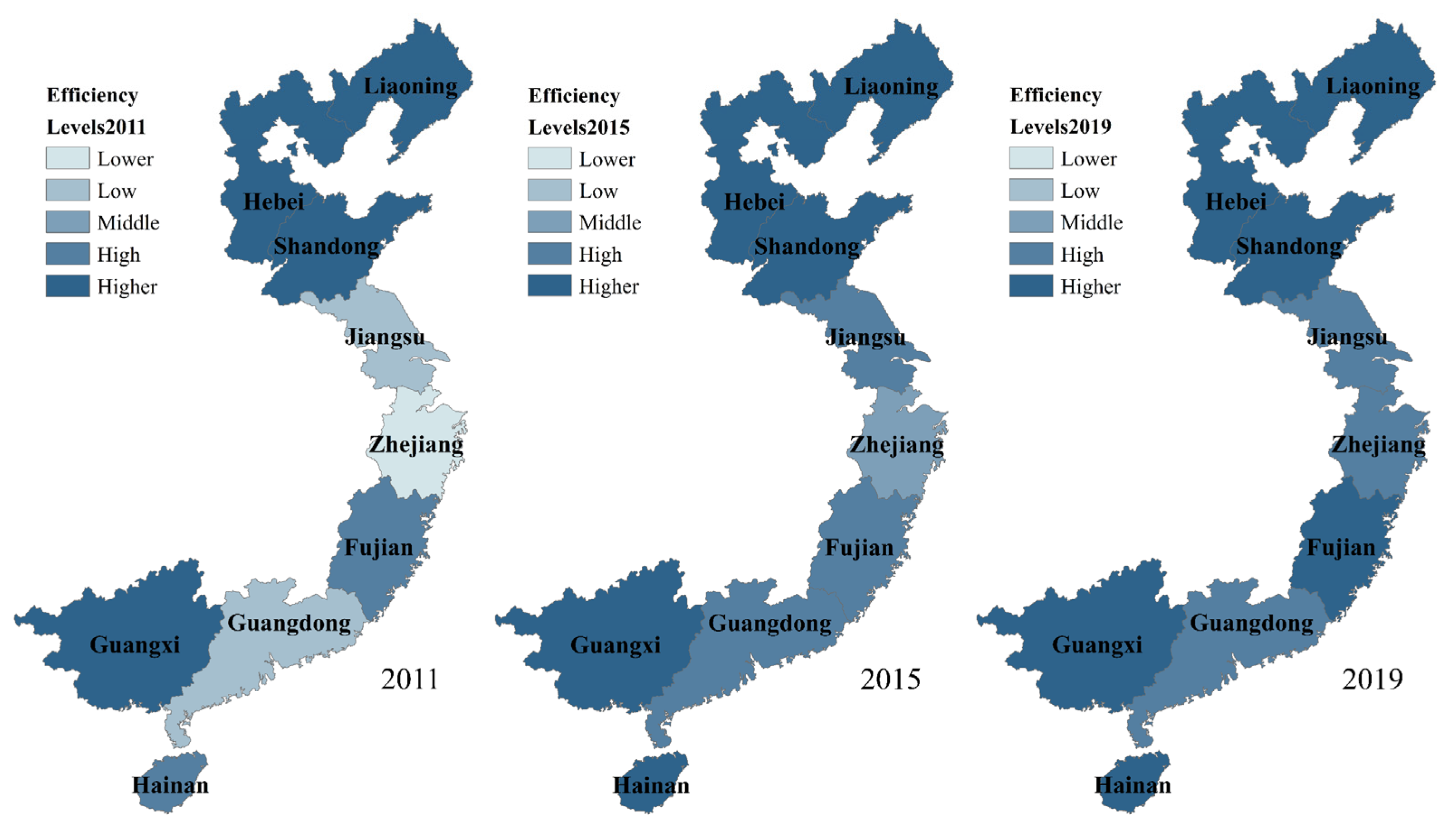Evaluation and Determinants of the Digital Inclusive Financial Support Efficiency for Marine Carbon Sink Fisheries: Evidence from China
Abstract
1. Introduction
2. Literature Review
2.1. Research on Marine Carbon Sink
2.2. Research on Digital Inclusive Finance
3. An Analytical Framework Based on Grounded Theory
3.1. Information Sources
3.2. Three-Level Coding
4. Materials and Methods
4.1. Empirical Models
4.1.1. The Grey Relational Analysis Model
- (1)
- The reference sequence and the comparison sequence need to be determined.
- (2)
- Based on Equation (3), the grey relational coefficients of the reference sequence X0 and the comparison sequence Xi at moment t: are calculated.
- (3)
- The grey correlation between the reference sequence X0 and the comparison sequence Xi is as follows.
4.1.2. The Super-EBM Model
4.1.3. The Tobit Model
4.2. Variables Selection
4.2.1. Digital Inclusive Finance and Marine Carbon Sinks
- (1)
- The index of digital inclusive finance
- (2)
- Marine carbon sinks
4.2.2. The Output and Input Variables in the Measurement of the DIFSE for Marine Carbon Sink Fisheries
4.2.3. Determinants Affecting the DIFSE for Marine Carbon Sink Fisheries
- (1)
- Resource input
- (2)
- Economic fundamental
- (3)
- Environmental impacts
4.3. Data
4.4. Statistical Analysis
5. Results
5.1. Whether There Is a Correlation between the Level of Digital Inclusive Finance and China’s Marine Carbon Sinks
5.2. The DIFSE for Marine Carbon Sink Fisheries
- (1)
- Analysis of the time variation in the DIFSE for marine carbon sink fisheries
- (2)
- Analysis of the regional differences in the DIFSE for marine carbon sink fisheries
5.3. What Factors Will Affect the DIFSE for Marine Carbon Sink Fisheries
- (1)
- In terms of the resource input
- (2)
- In terms of the economic fundamental
- (3)
- In terms of environmental impact
6. Conclusions and Discussion
6.1. Research Conclusions
6.2. Political Implications
6.3. Limitations and Future Research Directions
Author Contributions
Funding
Institutional Review Board Statement
Data Availability Statement
Acknowledgments
Conflicts of Interest
Appendix A
| Abbreviations | Definition or Full Names |
|---|---|
| DIFSE | Digital inclusive financial support efficiency |
| DEA | Data envelopment analysis |
| EBM | Epsilon-based measure of efficiency in data envelopment analysis |
| Super-EBM | Data envelopment analysis using epsilon-based measures to calculate the super-efficiency |
| BCC-DEA | Data envelopment analysis improved by Banker, Charnes and Cooper |
| CCR-DEA | Data envelopment analysis improved by Charnes, Cooper and Rhodes |
| SBM | Slacks-based measure of efficiency in data envelopment analysis |
| ATM | Automated teller machines |
| COVID-19 | Coronavirus disease 2019 |
| OLS | Ordinary least square |
| DMUs | Decision-making units |
| DOC | Dissolvable organic carbon |
| POC | Particulate organic carbon |
| EKC | Environmental Kuznets curve |
References
- Liu, J.B.; Feng, H.Y.; Wang, K. The Low-Carbon City Pilot Policy and Urban Land Use Efficiency: A Policy Assessment from China. Land 2022, 11, 604. [Google Scholar] [CrossRef]
- Barkh, H.; Yu, A.L.N.; Friend, D.; Shani, P.; Tu, Q.S.; Swei, O. Vehicle fleet electrification and its effects on the global warming potential of highway pavements in the United States. Resour. Conserv. Recycl. 2022, 185, 106440. [Google Scholar] [CrossRef]
- Barneze, A.S.; Whitaker, J.; McNamara, N.P.; Ostle, N.J. Interactions between climate warming and land management regulate greenhouse gas fluxes in a temperate grassland ecosystem. Sci. Total Environ. 2022, 833, 155212. [Google Scholar] [CrossRef]
- DeVries, T.; Le Quéré, C.; Andrews, O.; Berthet, S.; Hauck, J.; Ilyina, T.; Landschützer, P.; Lenton, A.; Lima Ivan, D.; Nowicki, M.; et al. Decadal trends in the ocean carbon sink. Proc. Natl. Acad. Sci. USA 2019, 116, 11646–11651. [Google Scholar] [CrossRef]
- Gao, Y.; Yu, G.; Yang, T.; Jia, Y.; He, N.; Zhuang, J. New insight into global blue carbon estimation under human activity in land-sea interaction area: A case study of China. Earth Sci. Rev. 2016, 159, 36–46. [Google Scholar] [CrossRef]
- Mullon, C. A constraint-based framework to study competition and cooperation in fishing. Fish. Res. 2018, 203, 74–83. [Google Scholar] [CrossRef]
- Li, J.; Wu, Y.; Xiao, J.J. The impact of digital finance on household consumption: Evidence from China. Econ. Model. 2020, 86, 317–326. [Google Scholar] [CrossRef]
- Liu, Z.; Zhang, Y.; Li, H. Digital Inclusive Finance, Multidimensional Education, and Farmers’ Entrepreneurial Behavior. Math. Probl. Eng. 2021, 2021, 6541437. [Google Scholar] [CrossRef]
- Frost, J.; Gambacorta, L.; Huang, Y.; Shin, H.S.; Zbinden, P. BigTech and the changing structure of financial intermediation. Econ. Policy 2019, 34, 761–799. [Google Scholar] [CrossRef]
- Riebesell, U.; Zondervan, I.; Rost, B.; Tortell, P.D.; Zeebe, R.E.; Morel, F.M.M. Reduced calcification of marine plankton in response to increased atmospheric CO2. Nature 2000, 407, 364–367. [Google Scholar] [CrossRef]
- Hmelo, L.R.; Mincer, T.J.; Van Mooy, B.A.S. Possible influence of bacterial quorum sensing on the hydrolysis of sinking particulate organic carbon in marine environments. Environ. Microbiol. Rep. 2011, 3, 682–688. [Google Scholar] [CrossRef] [PubMed]
- Liu, Z.; Xu, J.; Tian, J.; Wang, P. Calcium carbonate pump during Quaternary glacial cycles in the South China Sea. Chin. Sci. Bull. 2003, 48, 1862–1869. [Google Scholar] [CrossRef]
- Gonzalez, J.M.; Fernandez-Gomez, B.; Fernandez-Guerra, A.; Gomez-Consarnau, L.; Sanchez, O.; Coll-Llado, M.; del Campo, J.; Escudero, L.; Rodriguez-Martinez, R.; Alonso-Saez, L.; et al. Genome analysis of the proteorhodopsin-containing marine bacterium Polaribacter sp MED152 (Flavobacteria). Proc. Natl. Acad. Sci. USA 2008, 105, 8724–8729. [Google Scholar] [CrossRef]
- Bishop, J.K.B.; Wood, T.J. Year-round observations of carbon biomass and flux variability in the Southern Ocean. Glob. Biogeochem. Cycles 2009, 23, GB2019. [Google Scholar] [CrossRef]
- Seiter, K.; Hensen, C.; Zabel, M. Benthic carbon mineralization on a global scale. Glob. Biogeochem. Cycles 2005, 19, GB1010. [Google Scholar] [CrossRef]
- Jeong, H.J.; Yoo, Y.D.; Lee, K.; Kang, H.C.; Kim, J.S.; Kim, K.Y. Annual carbon retention of a marine-plankton community in the eutrophic Masan Bay, based on daily measurements. Mar. Biol. 2021, 168, 69. [Google Scholar] [CrossRef]
- Alpert, S.B.; Spencer, D.F.; Hidy, G. Biospheric options for mitigating atmospheric carbon dioxide levels. Energy Convers. Manag. 1992, 33, 729–736. [Google Scholar] [CrossRef]
- Tang, Q.; Zhang, J.; Fang, J. Shellfish and seaweed mariculture increase atmospheric CO2 absorption by coastal ecosystems. Mar. Ecol. Prog. Ser. 2011, 424, 97–104. [Google Scholar] [CrossRef]
- Lapointe, B.E.; Littler, M.M.; Littler, D.S. A comparison of nutrient-limited productivity in macroalgae from a Caribbean barrier reef and from a mangrove ecosystem. Aquat. Bot. 1987, 28, 243–255. [Google Scholar] [CrossRef]
- Lai, Q.; Ma, J.; He, F.; Zhang, A.; Pei, D.; Yu, M. Current and Future Potential of Shellfish and Algae Mariculture Carbon Sinks in China. Int. J. Environ. Res. Public Health 2022, 19, 8873. [Google Scholar] [CrossRef]
- Wu, J.; Li, B. Spatio-temporal evolutionary characteristics of carbon emissions and carbon sinks of marine industry in China and their time-dependent models. Mar. Policy 2022, 135, 104879. [Google Scholar] [CrossRef]
- Beck, T.; Demirguc-Kunt, A.; Martinez Peria, M.S. Reaching out: Access to and use of banking services across countries. J. Financ. Econ. 2007, 85, 234–266. [Google Scholar] [CrossRef]
- Sarma, M.; Pais, J. Financial Inclusion and Development. J. Int. Dev. 2011, 23, 613–628. [Google Scholar] [CrossRef]
- Demirguec-Kunt, A.; Klapper, L. Measuring Financial Inclusion: Explaining Variation in Use of Financial Services across and within Countries. In Brookings Papers on Economic Activity; Johns Hopkins University Press: Baltimore, MD, USA, 2013; pp. 279–340. [Google Scholar]
- Guo, F.; Wang, J.; Wang, F.; Kong, T.; Zhang, X.; Cheng, Z. Measuring China’s digital financial inclusion: Index compilation and spatial characteristics. China Econ. Q. 2020, 19, 1401–1418. [Google Scholar]
- Hinson, R.; Lensink, R.; Mueller, A. Transforming agribusiness in developing countries: SDGs and the role of FinTech. Curr. Opin. Environ. Sustain. 2019, 41, 1–9. [Google Scholar] [CrossRef]
- Gao, Q.; Cheng, C.; Sun, G.; Li, J. The impact of digital inclusive finance on agricultural green total factor productivity: Evidence from China. Front. Ecol. Evol. 2022, 10, 905644. [Google Scholar] [CrossRef]
- Guo, H.; Gu, F.; Peng, Y.; Deng, X.; Guo, L. Does Digital Inclusive Finance Effectively Promote Agricultural Green Development?—A Case Study of China. Int. J. Environ. Res. Public Health 2022, 19, 6982. [Google Scholar] [CrossRef]
- Zhong, R.; He, Q.; Qi, Y. Digital Economy, Agricultural Technological Progress, and Agricultural Carbon Intensity: Evidence from China. Int. J. Environ. Res. Public Health 2022, 19, 6488. [Google Scholar] [CrossRef]
- Fang, D.; Zhang, X. The Protective Effect of Digital Financial Inclusion on Agricultural Supply Chain during the COVID-19 Pandemic: Evidence from China. J. Theor. Appl. Electron. Commer. Res. 2021, 16, 3202–3217. [Google Scholar] [CrossRef]
- Zhao, P.P.; Zhang, W.; Cai, W.C.; Liu, T.J. The impact of digital finance use on sustainable agricultural practices adoption among smallholder farmers: An evidence from rural China. Environ. Sci. Pollut. Res. 2022, 29, 39281–39294. [Google Scholar] [CrossRef]
- Adegbite, O.O.; Machethe, C.L. Bridging the financial inclusion gender gap in smallholder agriculture in Nigeria: An untapped potential for sustainable development. World Dev. 2020, 127, 104755. [Google Scholar] [CrossRef]
- Zhou, M.; Zheng, X. Evaluation of the Development of Fintech-Served Real Economy Based on Fintech Improvement. Discret. Dyn. Nat. Soc. 2021, 2021, 4836933. [Google Scholar] [CrossRef]
- Chen, X.Y.; Wang, Y. Research on financing efficiency of China’s strategic emerging industries based on super efficiency DEA and tobit model. Int. J. Emerg. Mark. 2022, 17, 485–504. [Google Scholar] [CrossRef]
- Jin, F.; Yan, Z.; Wu, Q. Research on the Efficiency of Digital Inclusive Finance in Alleviating Relative Poverty. J. Financ. Dev. Res. 2021, 1, 14–21. [Google Scholar] [CrossRef]
- Banker, R.D.; Charnes, A.; Cooper, W.W. Some Models for Estimating Technical and Scale Inefficiencies in Data Envelopment Analysis. Manag. Sci. 1984, 30, 1078–1092. [Google Scholar] [CrossRef]
- Ren, H.; Wang, Y. A Study on the Efficiency Evaluation and Influencing Factors of Digital Inclusive Finance under the Strategy of Rural Revitalization in Western China. J. Lanzhou Univ. Soc. Sci. 2021, 49, 40–48. [Google Scholar] [CrossRef]
- Chen, Y.; Sun, Y. Determinants of platform ecosystem health: An exploration based on grounded theory. J. Bus. Econ. Manag. 2021, 22, 1142–1159. [Google Scholar] [CrossRef]
- Corbin, J.M.; Strauss, A. Grounded theory research: Procedures, canons, and evaluative criteria. Qual. Sociol. 1990, 13, 3–21. [Google Scholar] [CrossRef]
- Wang, X.; Wang, Q. Research on the impact of green finance on the upgrading of China’s regional industrial structure from the perspective of sustainable development. Resour. Policy 2021, 74, 102436. [Google Scholar] [CrossRef]
- Wen, K. The quantized transformation in Deng’s grey relational grade. Grey Syst. Theory Appl. 2016, 6, 375–397. [Google Scholar] [CrossRef]
- Charnes, A.; Cooper, W.W.; Rhodes, E. Measuring the efficiency of decision making units. Eur. J. Oper. Res. 1978, 2, 429–444. [Google Scholar] [CrossRef]
- Wu, D.; Wang, Y.; Qian, W. Efficiency evaluation and dynamic evolution of China’s regional green economy: A method based on the Super-PEBM model and DEA window analysis. J. Clean. Prod. 2020, 264, 121630. [Google Scholar] [CrossRef]
- Tone, K.; Tsutsui, M. An epsilon-based measure of efficiency in DEA—A third pole of technical efficiency. Eur. J. Oper. Res. 2010, 207, 1554–1563. [Google Scholar] [CrossRef]
- Andersen, P.; Petersen, N.C. A Procedure for Ranking Efficient Units in Data Envelopment Analysis. Manag. Sci. 1993, 39, 1261–1264. [Google Scholar] [CrossRef]
- Tobin, J. Estimation of Relationships for Limited Dependent Variables. Econometrica 1958, 26, 24–36. [Google Scholar] [CrossRef]
- Liu, C.; Liu, G.; Casazza, M.; Yan, N.; Xu, L.; Hao, Y.; Franzese, P.P.; Yang, Z. Current Status and Potential Assessment of China’s Ocean Carbon Sinks. Environ. Sci. Technol. 2022, 56, 6584–6595. [Google Scholar] [CrossRef]
- Xu, J.; Zhang, j.; She, C. Evaluation of spatial spillover effect of green development of marine carbon sink fisheries. China Popul. Resour. Environ. 2020, 30, 99–110. [Google Scholar]
- Qin, H.; Zhang, Y.; Lu, Y. Measurement and Analysis of China’s Mariculture Eco-economic Efficiency: Based on SBM Model. J. Agrotech. Econ. 2018, 9, 67–79. [Google Scholar] [CrossRef]
- Lin, X.H.; Zheng, L.; Li, W.W. Measurement of the contributions of science and technology to the marine fisheries industry in the coastal regions of China. Mar. Policy 2019, 108, 103647. [Google Scholar] [CrossRef]
- Hobza, V.; Hamrik, Z.; Bucksch, J.; De Clercq, B. The Family Affluence Scale as an Indicator for Socioeconomic Status: Validation on Regional Income Differences in the Czech Republic. Int. J. Environ. Res. Public Health 2017, 14, 1540. [Google Scholar] [CrossRef]
- Hu, C.; Fan, J.; Chen, J. Spatial and Temporal Characteristics and Drivers of Agricultural Carbon Emissions in Jiangsu Province, China. Int. J. Environ. Res. Public Health 2022, 19, 12463. [Google Scholar] [CrossRef] [PubMed]
- Guo, J.; Luo, P. Has the Internet contributed to total factor productivity in China? J. Manag. World 2016, 10, 34–49. [Google Scholar] [CrossRef]
- Qian, Z.; Liu, X. Regional Differences in China’s Green Economic Efficiency and Their Determinants. China Popul. Resour. Environ. 2013, 23, 104–109. [Google Scholar]
- Ma, W.; Feng, Z. Analysis of Factors Affecting Grain Production in China—An Empirical Study Based on Panel Data. Shaanxi J. Agric. Sci. 2008, 1, 163–166. [Google Scholar]
- Wang, D. A study on the productivity of Chinese aquaculture industry and its influencing factors. Ocean Dev. Manag. 2013, 30, 94–98. [Google Scholar]
- Zhang, X.; Zheng, S.; Yu, L. Green Efficiency Measurement and Spatial Spillover Effect of China’s Marine Carbon Sequestration Fishery. Chin. Rural Econ. 2020, 10, 91–110. [Google Scholar]
- Xu, L.; Lai, Q.; Yan, C. An Analysis of the Correlation between Financial Development and Marine Economy and Measuring the Financial Support Efficiency in Marine Industry in China. J. Stat. Inf. 2019, 34, 64–75. [Google Scholar]
- Elhendy, A.M.; Alkahtani, S.H. Efficiency and Productivity Change Estimation of Traditional Fishery Sector at the Arabian Gulf: The Malmquist Productivity Index Approach. J. Anim. Plant Sci. 2012, 22, 300–308. [Google Scholar]
- Liang, W.; Yang, M. Urbanization, economic growth and environmental pollution: Evidence from China. Sustain. Comput. Inform. Syst. 2019, 21, 1–9. [Google Scholar] [CrossRef]
- Jin, L.; Duan, K.; Shi, C.; Ju, X. The Impact of Technological Progress in the Energy Sector on Carbon Emissions: An Empirical Analysis from China. Int. J. Environ. Res. Public Health 2017, 14, 1505. [Google Scholar] [CrossRef]
- Chen, Q.; Zhang, Y.B.; Chen, L. A Study of Internet Development and Enterprise Financing in China. Netw. Spat. Econ. 2021, 21, 495–511. [Google Scholar] [CrossRef]
- Hai, A.T.N.; Speelman, S. Economic-environmental trade-offs in marine aquaculture: The case of lobster farming in Vietnam. Aquaculture 2020, 516, 734593. [Google Scholar] [CrossRef]
- Umuhire, M.L.; Fang, Q. Method and application of ocean environmental awareness measurement: Lessons learnt from university students of China. Mar. Pollut. Bull. 2016, 102, 289–294. [Google Scholar] [CrossRef] [PubMed]
- Wang, S.L.; Xu, X.R.; Sun, Y.X.; Liu, J.L.; Li, H.B. Heavy metal pollution in coastal areas of South China: A review. Mar. Pollut. Bull. 2013, 76, 7–15. [Google Scholar] [CrossRef]




| Variables | Symbol | Variable Definitions | Mean | Standard Deviation |
|---|---|---|---|---|
| Digital Inclusive Finance | DIF | Digital Financial Inclusion Index (index) | 214.34 | 91.65 |
| Usage Depth | UD | Level 1 indicators of DIF (index) | 215.16 | 90.63 |
| Coverage Breadth | CB | Level 1 indicators of DIF (index) | 194.81 | 89.16 |
| Degree of Digitization | DD | Level 1 indicators of DIF (index) | 277.32 | 119.96 |
| Credit Operations | CRE | Level 2 indicators of DIF (index) | 147.49 | 53.81 |
| Marine Carbon Sinks | MCS | The marine carbon sink capacity (10,000 tons) | 13.80 | 11.65 |
| Variables | Symbol | Variable Definitions | Mean | Standard Deviation | |
|---|---|---|---|---|---|
| Resource input | Productive factors | factors | Sum of the standardized values of marine carbon sink fishery breeding sites area, labor, seedlings, power of fishing vessels, and intermediate consumption (index) | 1.16 | 0.67 |
| Promotion of fishery skill | skill | Sum of the standardized values of aquatic skill business promotion funds and the number of fishermen skillfully trained in marine carbon sink fisheries (index) | 0.48 | 0.34 | |
| Fishery technology | tech | Sum of the standardized values of the number of research papers and patents related to marine carbon sink fisheries (index) | 0.74 | 0.51 | |
| Economic fundamental | Output structure | structure | Marine carbon sink fishery production/total mariculture production (ratio) | 0.76 | 0.22 |
| Income level | income | Regional per capita disposable income (yuan) | 31,909.37 | 8339.97 | |
| Internet coverage | IC | Regional Internet broadband access users/the number of the regional resident population. (ratio) | 0.23 | 0.09 | |
| Environmental impacts | Marine pollution | pollution | Marine wastewater discharge (10,000 tons) | 69,610.78 | 70,600.59 |
| Environmental regulation | ER | Number of marine pollution control investment projects (number) | 54,161.56 | 55,156.09 | |
| Fishery disaster | disaster | Affected area of breeding sites/total area (ratio) | 0.10 | 0.11 | |
| Aquaculture drug | drug | Percentage of fishery drug output value in total mariculture output value (percentage) | 0.34 | 0.74 |
| Provinces | DIF | CB | UD | DD | CRE | |
|---|---|---|---|---|---|---|
| North | Hebei | 0.6568 | 0.5462 | 0.7539 | 0.7063 | 0.8990 |
| Liaoning | 0.6392 | 0.6830 | 0.6533 | 0.5010 | 0.7655 | |
| Shandong | 0.5706 | 0.5691 | 0.6285 | 0.5028 | 0.8361 | |
| Mean | 0.6222 | 0.5994 | 0.6785 | 0.5700 | 0.8335 | |
| East | Jiangsu | 0.8371 | 0.8659 | 0.8706 | 0.5074 | 0.9283 |
| Zhejiang | 0.8379 | 0.8767 | 0.8588 | 0.5082 | 0.9318 | |
| Mean | 0.8375 | 0.8713 | 0.8647 | 0.5078 | 0.9301 | |
| South | Fujian | 0.6458 | 0.6748 | 0.6837 | 0.5039 | 0.8171 |
| Guangdong | 0.5801 | 0.5764 | 0.6316 | 0.5154 | 0.7946 | |
| Guangxi | 0.6357 | 0.5385 | 0.7186 | 0.6865 | 0.8175 | |
| Hainan | 0.6337 | 0.5611 | 0.7115 | 0.6695 | 0.8425 | |
| Mean | 0.6238 | 0.5877 | 0.6863 | 0.5938 | 0.8179 |
| Province | 2011 | 2012 | 2013 | 2014 | 2015 | 2016 | 2017 | 2018 | 2019 | Mean | Rank |
|---|---|---|---|---|---|---|---|---|---|---|---|
| Hebei | 1.0150 | 1.0014 | 1.0028 | 1.0348 | 1.0196 | 1.0146 | 1.0063 | 1.0246 | 1.0057 | 1.0139 | 2 |
| Liaoning | 1.0378 | 1.0030 | 0.9214 | 0.9471 | 1.0006 | 0.9667 | 0.9862 | 1.0027 | 1.0137 | 0.9866 | 4 |
| Jiangsu | 0.5090 | 0.6865 | 0.6897 | 0.7452 | 0.7754 | 0.8247 | 0.8496 | 0.8320 | 0.8290 | 0.7490 | 8 |
| Zhejiang | 0.4390 | 0.5796 | 0.5918 | 0.6618 | 0.6999 | 0.7641 | 0.7963 | 0.7818 | 0.7782 | 0.6769 | 9 |
| Fujian | 0.7029 | 0.8513 | 0.8563 | 0.8818 | 0.8376 | 0.8649 | 0.8776 | 0.8756 | 1.0000 | 0.8609 | 6 |
| Shandong | 1.3888 | 1.1782 | 1.1607 | 1.1324 | 1.1869 | 1.1512 | 1.1393 | 1.1426 | 1.1132 | 1.1770 | 1 |
| Guangdong | 0.5269 | 0.7396 | 0.7409 | 0.7879 | 0.8006 | 0.8549 | 0.8564 | 0.8480 | 0.8403 | 0.7773 | 7 |
| Guangxi | 1.0557 | 1.0250 | 1.0745 | 0.9771 | 1.0001 | 0.9933 | 1.0009 | 0.9821 | 1.0039 | 1.0125 | 3 |
| Hainan | 0.7562 | 0.8836 | 0.8910 | 1.0172 | 0.9527 | 1.0114 | 0.9735 | 0.8991 | 0.9562 | 0.9268 | 5 |
| Mean | 0.8257 | 0.8831 | 0.8810 | 0.9095 | 0.9193 | 0.9384 | 0.9429 | 0.9321 | 0.9489 |
| Variables | Coef. | Std. Err. | t | P |
|---|---|---|---|---|
| factors | 0.0971 *** | 0.0298 | 3.2600 | 0.0020 |
| skill | 0.1803 * | 0.1067 | 1.6900 | 0.0950 |
| tech | 0.0864 *** | 0.0243 | 3.5600 | 0.0010 |
| structure | −0.2204 ** | 0.0943 | −2.3400 | 0.0220 |
| Lnincome | −0.2288 * | 0.1257 | −1.8200 | 0.0730 |
| IC | 0.6593 * | 0.3761 | 1.7500 | 0.0840 |
| Lnpollution | −0.0886 *** | 0.0246 | −3.6000 | 0.0010 |
| LnER | 0.0074 | 0.0147 | 0.5100 | 0.6140 |
| disaster | −0.8219 *** | 0.2343 | −3.5100 | 0.0010 |
| drug | 0.0056 | 0.0347 | 0.1600 | 0.8730 |
| Cons | 3.9619 *** | 1.1476 | 3.4500 | 0.0010 |
| Log pseudolikelihood | 69.1129 | Obs | 81 |
Publisher’s Note: MDPI stays neutral with regard to jurisdictional claims in published maps and institutional affiliations. |
© 2022 by the authors. Licensee MDPI, Basel, Switzerland. This article is an open access article distributed under the terms and conditions of the Creative Commons Attribution (CC BY) license (https://creativecommons.org/licenses/by/4.0/).
Share and Cite
Xu, W.; Zhu, X. Evaluation and Determinants of the Digital Inclusive Financial Support Efficiency for Marine Carbon Sink Fisheries: Evidence from China. Int. J. Environ. Res. Public Health 2022, 19, 13971. https://doi.org/10.3390/ijerph192113971
Xu W, Zhu X. Evaluation and Determinants of the Digital Inclusive Financial Support Efficiency for Marine Carbon Sink Fisheries: Evidence from China. International Journal of Environmental Research and Public Health. 2022; 19(21):13971. https://doi.org/10.3390/ijerph192113971
Chicago/Turabian StyleXu, Weicheng, and Xiangyu Zhu. 2022. "Evaluation and Determinants of the Digital Inclusive Financial Support Efficiency for Marine Carbon Sink Fisheries: Evidence from China" International Journal of Environmental Research and Public Health 19, no. 21: 13971. https://doi.org/10.3390/ijerph192113971
APA StyleXu, W., & Zhu, X. (2022). Evaluation and Determinants of the Digital Inclusive Financial Support Efficiency for Marine Carbon Sink Fisheries: Evidence from China. International Journal of Environmental Research and Public Health, 19(21), 13971. https://doi.org/10.3390/ijerph192113971






